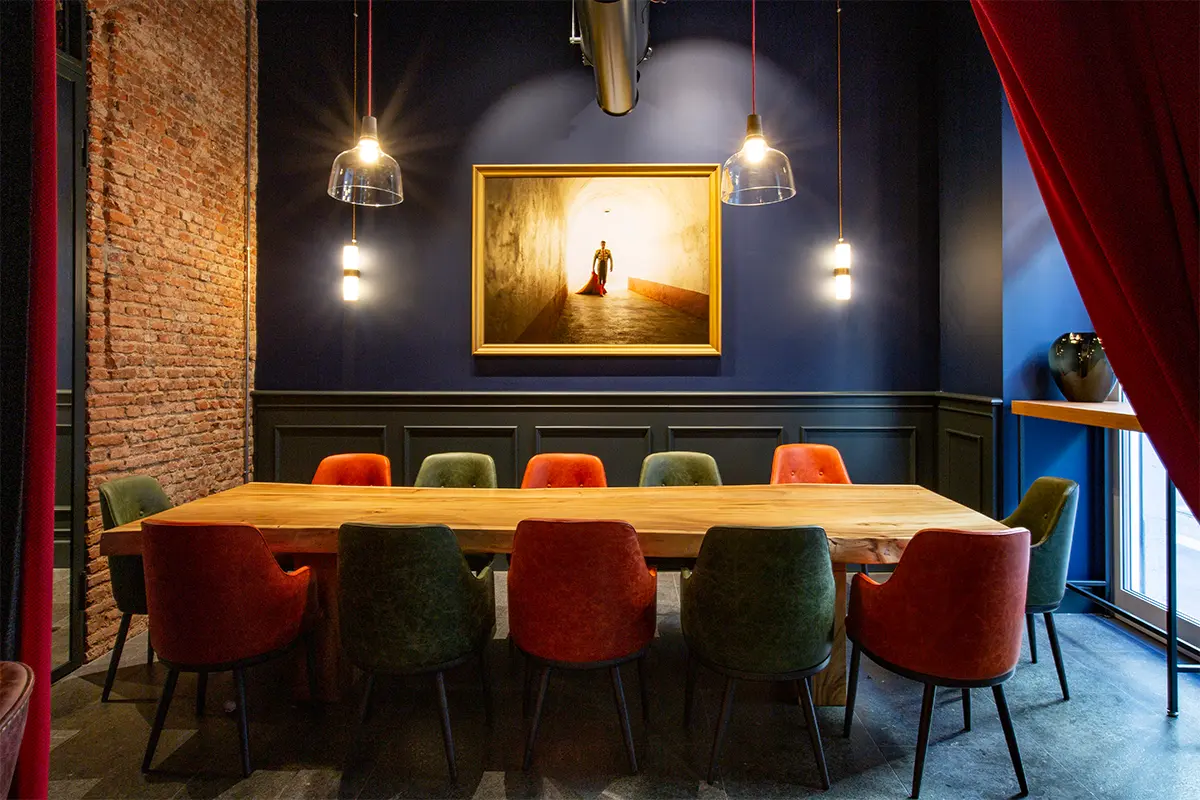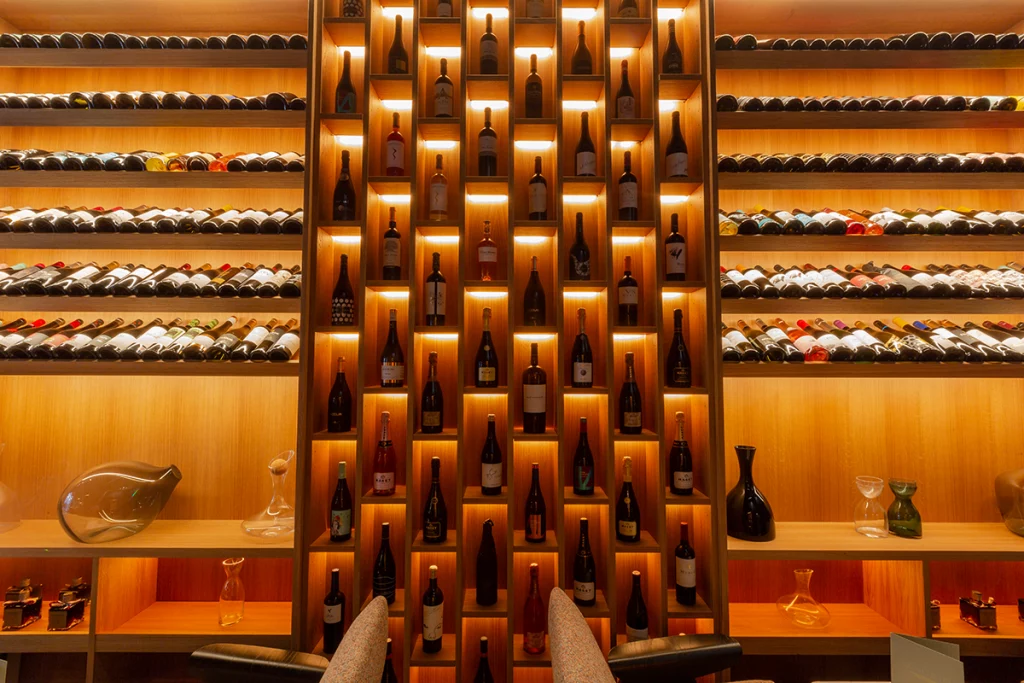Señorío is a contemporary restaurant that fits well into Milan’s cosmopolitan scene, fueling the cultural exchange between Italy and Spain
International cuisine in Milan
Typical Milanese cuisine is international. The desire to experiment, an openness to diversity and a cosmopolitan nature are factors that make Milan not only the most Italian international city, but also the Milanese inhabitant a curious fork. On the Oriental and Japanese cuisine front, Milanese declinations are endless, at every level of quality. We can start by saying the same about South American cuisine – Mexican, Argentinian and Brazilian especially. Russian cuisine restaurants there are two, mid-range. Spain is fairly well represented but lacked a fine restaurant that was not too much about tapas or too much of a modern interpretation of traditional dishes.
Señorío – Patio gastronómico español
What was missing was a real, fine Spanish cuisine restaurant. Now it’s there. The Para Comer Algo group opened in 2022 Señorío – Patio gastronómico español, seventy seats on Via via Bramante, between Porta Volta and Borgo degli Ortolani. The atmosphere is that of old-time Milan, but projected into the future. A series of well-maintained late 19th-century buildings make up the street that leads to the international and multi-ethnic China Town.
Señorío is a contemporary restaurant that fits well into Milan’s cosmopolitan scene, fueling the cultural exchange between Italy and Spain. These are two country that are close not only because of their shared history and geographic proximity, but also because of the movement of their citizens-intense and, in recent years, increasingly pronounced-between the two societies. Italians are Barcelona’s first resident foreign community and one of the first in all of Spain. They became fully integrated both culturally and professionally. Even in the kitchen, the links that unite the Italian culinary heritage and the gastronomy of Spain and Catalonia are evident, expressions of a common denominator that is the Mediterranean with its authentic and quality products.
Spanish architect Andrés Córdoba designed the interiors of Señorío, Milan
The 300 square meters restaurant was designed by Spanish architect Andrés Córdoba, brother of former soccer player Ivan and an architect who has been a partner in the Milan firm Ma2a since 2010. Three large windows give a glimpse of the interior of the bar, illuminated by soft lighting. One enters the American Spanish bar. The food is displayed on the counter as in any typical one. Fish, shellfish and crustaceans are displayed in other showcases, and meat in a refrigerator. A table carved from a thousand-year-old American redwood tree surprises the customer. One continues to the left towards a corridor, furnished with low tables and comfortable armchairs – the ideal place to enjoy a good glass of wine. On the wall, a wooden bookcase holds books and bottles.
Spanish art and culture
One enters the second room, the heart of the restaurant. The intimate atmosphere is favored by a skillful use of light, which is never intrusive. The lighting was conceived by designers such as Patricia Urquiola and Chris Basias, who designed different wall lamps, Valerio Sommella & Anonima Luci and Noé Duchaufour Lawrence, on the other hand, created the pendant lamps. The furniture was designed by Valencian studio Aranda Aloy Enblanc, while.
Not only furniture, but also collectibles and artworks embellish the spaces: distributed throughout the different spaces is a collection of 18 pieces made of glass and designed by designer Ron Arad inspired by Spanish art and culture. A dedication to the bullfighter Paquirri looms large with the display of his Traje de Luces – dressed in light, the traditional dress of bullfighters. Several works by Catalan painter Antoni Tàpies and Valencian painter Antoni Miró Bravo, a work by Pesaro painter Claudio Sacchi of Spanish inspiration and nature, and the guitar of Paco De Lucía, Spanish composers and guitarists.
Outside, in the old Milanese courtyard, is the covered patio and, beyond, another room with a single table and the Vinoteca, an independent space where 3650 bottles of more than 500 Iberian labels are displayed. On the walls, bright colors and works by contemporary Iberian artists.
Chef Alberto Rodriguez as the kitchen guide at Señorío
Spanish chef Alberto Rodríguez, directs the kitchen at Señorío, working with 100% Hecho en España products. This is another element that unites Italy and Spain: attention to raw materials, which is not an imposed choice, but a natural approach derived from a centuries-old tradition. Senorio attempts to combine the two realities that coexist in today’s Spanish cuisine: a classic and popular one based on tradition and a current cuisine that uses the most innovative and ingenious author cooking techniques.
The menu involves every region of the Spanish territory using only quality products that arrive with a traceability label and designation of origin, and is based on the seasonality of the products with special proposals present throughout the year.
In autumn you can enjoy Romescada de Peix – a fish soup with romesco sauce; in winter you visit the Basque Country through Cod a la Pil Pil, cooked slowly at a low temperature in olive oil or Callos a la Madrileña, a stew prepared with different types of meat; in springtime on the plate are the colors of Andalusia – La Migas is traditional from Córdoba, prepared with stale bread and served with melon and barbecued sardines, or the Andalusian mixed fry whose frying becomes pleasantly crispy, thanks to the use of chickpea flour; in summer you can refresh yourself with Ajo Blanco, a cold soup typical of Málaga, or enjoy Albóndigas de Choco – cuttlefish balls – a traditional recipe from Huelva.
Para picar – pan tomates and cured meats, as well as jamon iberico
One constant: pan tomate and cured meats, which are good all year round. Prominent among these, of course, is Jamón Ibérico, also in the 100% Pata Negra variety, sourced exclusively from pure-bred Iberian pigs, raised in the wild and fed only acorns.
Pork consumption is widespread throughout the territory, with Spain being one of the largest consumers (and producers) of this meat in the European Union. There is an indigenous breed: the Iberian pig, which is highly prized. Most of the pig is dedicated to butchery, which has different varieties of sausages in each region of Spain, such as chorizos, black pudding and morcones (botillos. The variety of sausages is such that each region has its own style and taste in preparation. Common is the consumption of piglets or suckling pigs (usually roasted). However, by far the most popular pork product among Spaniards is ham, which is ubiquitous in all culinary fields and in much of the territory, pig slaughtering is practiced, a traditional family activity carried out in winter and which is gradually being lost.
Señorío’s meats
Señorío’s meats are of certified origin and indigenous breeds from the regions for breeding, and are offered in different cuts and cooking. Thus some examples are Chuletón a la brasa de Vaca Rubia Gallega D.O. – barbecued rib-eye steak – and Cochinillo de Segovia D.O – suckling pig in low temperature cooking.
Para Comer Algo
The Para Comer Algo group is a Hispanic American food and restaurant group with a total of 23 locations in different countries around the world and among the group’s projects is La Boqueria, which has eight Spanish cuisine restaurants in the United States. Their business also includes distribution of food products from different countries, including products from Spain.




















